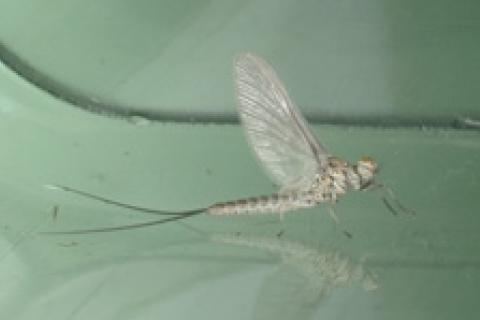
When my mind drifts back to memorable hatches I've fished, none can compare with the tiny Blue-Winged Olive or Baetis mayflies. There were days when the Olives emerged so heartily that trout fishing dreams became reality. I even fished a tremendous grayling rise once on a plunging northern Saskatchewan river where the smoky-winged Olives emerged by the thousands on a cold, shower-swept day.
 |
| The blue-winged olive fly is great to use this time of year. Photo courtesy of Jason Akl |
And that's another thing that makes fishing this hatch such an intense experience. They often emerge heaviest and draw the strongest feeding from trout when the air is leaden and showers spit from the sky or winter snowflakes rush sideways through the air.
The flies can emerge virtually any month, and I've fished them on Pennsylvania's limestone streams often on frigid winter days. Spring can be even better, but fall is also a great time to find Olives hatching.
Often they overshadow more heralded hatches, such as Hendricksons. You can find them on neutral pH streams, but they do best in alkaline waters. Spring creeks and tailwaters are prime. Areas with vegetation and shallow gravel runs are especially good.
Sizes of the various members of this genus can range from 4 mm to 10 mm, matched by hook sizes 14 to 24. The most common sizes are 16-20.
As far as time of day, mid-afternoon is the best period to find Olives emerging. Look for hatches when the water temperature is in the upper 40s to low 50s.
Nymphs of this insect are slender and very active. Imitations of them can be effective shortly before a hatch or even during its early stages. A Pheasant Tail pattern works especially well.
Once duns start popping out, switch to emergers. As the hatch progresses, turn to full dun patterns with erect wings. A traditional pattern will work, but I've had better luck with thorax, parachute, Comparadun and no-hackle dressings. The bodies of these flies can range from bright olive to a dark, grayish brown. You can tie a variety of colors to match these various shades, or simply blend all three colors of rabbit fur into an amalgam that works well for all Baetis hatches. Wings should be medium to dark gray.
Nymph and dun fishing may last several hours, but spinner falls can also provide excellent fishing. Use a rusty brown-colored body with light to medium gray clipped hackles or polypropylene wings to imitate these mating insects. They generally return to the stream from late afternoon into early evening. At times a subsurface pattern such as a Blue Dun wet fly yields exciting action during these spinner falls.
For all phases of fishing the Blue-Winged Olives I like a 3-5 weight rod, floating double taper or weight forward line and 10-12 foot leader tapering to a 5-7X tippet.
So whether you're closest to a tailwater fishery in Arkansas, a big western river or a spring creek in Virginia, don't overlook the BWO's. They can provide some of the most memorable fishing of the year over the next few months, even when snow spits from leaden skies and ice freezes in your rod guides.
For step-by-step instructions on how to tie the Blue-winged Olive, visit Jason Akl's Tying the Blue-winged Olive.
- 2291 views

